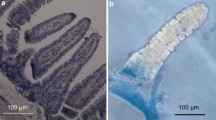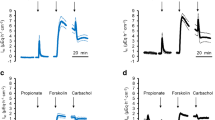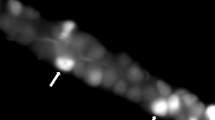Summary
Bicarbonate is transferred across the serosal (S) membrane of the epithelial cells of the turtle bladder in two directions. Cellular HCO −3 generated behind the H+ pump moves across this membrane into the serosal solution. This efflux of HCO −3 is inhibited by SITS (4-isothiocyano-4′-acetamido-2,2′-disulfonic stilbene). When HCO −3 is added to the serosal solution it is transported across the epithelium in exchange for absorbed Cl−. This secretory HCO −3 flow traverses the serosal cell membrane in the opposite direction. In this study the effects of serosal addition of 5×10−4 m SITS on HCO −3 secretion and Cl− absorption were examined. The rate of H+ secretion was brought to zero by an opposing pH gradient, and 20mm HCO −3 was added toS. HCO −3 secretion, measured by pH stat titration, was equivalent to the increase inM→S Cl− flux after HCO −3 addition. Neither theS→M flux of HCO −3 nor theM→S flux of Cl− were affected by SITS. In the absence of electrochemical gradients, net Cl− absorption was observed only in the presence of HCO −3 in the media; under such conditions, unidirectional and net fluxes of Cl− were not altered by serosal or mucosal SITS. H+ secretion, however, measured simultaneously as the short-circuit current in ouabain-treated bladders decreased markedly after serosal SITS. The inhibition of the efflux of HCO −3 in series with the H+ pump and the failure of SITS to affect HCO −3 secretion and Cl− absorption suggest that the epithelium contains at least two types of transport systems for bicarbonate in the serosal membrane.
Similar content being viewed by others
References
Cabantchik, Z.I., Rothstein, A. 1972. The nature of the membrane sites controlling anion permeability of human red blood cells as determined by studies with disulfonic stilbene derivatives.J. Membrane Biol. 10:311
Cohen, L.H., Mueller, A., Steinmetz, P.R. 1978. Inhibition of the bicarbonate exit step in urinary acidification by a disulfonic stilbene.J. Clin. Invest. 61:981
Ehrenspeck, G., Brodsky, W.A. 1976. Effects of 4-acetamido-4′-isothiocyano-2,2′-disulfonic stilbene on ion transport in turtle bladders.Biochim. Biophys. Acta 419:555
Fromter, E. 1977. Mechanism of H+/HCO −3 transport in rat kidney proximal tubule and mode of action of carbonic anhydrase inhibitors.Proc. Int. Physiol. Sci. 12:204
Gonzalez, C.F., Shamoo, Y.E., Brodsky, W.A. 1967. Electrical nature of active chloride transport across short-circuited turtle bladders.Am. J. Physiol. 212:641
Knauf, P.A., Fuhrmann, G.F., Rothstein, S., Rothstein, A. 1977. The relationship between anion exchange and net anion flow across the human red blood cell membrane.J. Gen. Physiol. 69:363
Knauf, P.A., Rothstein, A. 1971. Chemical modification of membranes. I. Effects of sulfhydryl and amino reactive reagents on anion and cation permeability of the human red cell.J. Gen. Physiol. 58:190
Leslie, B.R., Schwartz, J.H., Steinmetz, P.R. 1973. Coupling between Cl− absorption and HCO −3 secretion in turtle urinary bladder.Am. J. Physiol. 225:610
Mueller, A.L., Kessel, R.G., Husted, R.F., Cohen, L.H., Steinmetz, P.R. 1978. Effects of a disulfonic stilbene (SITS) on surface morphology and urinary acidification in turtle bladder.Fed. Proc. 37(3):511
Oliver, J.A., Himmelstein, S., Steinmetz, P.R. 1975. Energy dependence of urinary bicarbonate secretion in turtle bladder.J. Clin. Invest. 55:1003
Schwartz, J.H. 1976. H+ current response to CO2 and carbonic anhydrase inhibition in turtle bladder.Am. J. Physiol. 231:565
Schwartz, J.H., Finn, J.T., Vaughn, G., Steinmetz, P.R. 1974. Distribution of metabolic CO2 and the transported ion species in acidification by turtle bladder.Am. J. Physiol. 226:283
Snedecor, G.W., Cochran, W.G. 1967. Statistical Methods. (6th Ed.) Iowa State University Press, Ames
Solinger, R.E., Gonzalez, C.F., Shamoo, Y.E., Wyssbrod, H.R., Brodsky, W.A. 1968. Effect of ouabain on ion transport mechanisms in the isolated turtle bladder.Am. J. Physiol. 215:249
Steinmetz, P.R. 1967. Characteristics of hydrogen ion transport in urinary bladder of water turtle.J. Clin. Invest. 46:1531
Steinmetz, P.R. 1974. Cellular mechanisms of urinary acidification.Physiol. Rev. 54:890
Steinmetz, P.R., Lawson, L.R. 1971. Effect of luminal pH on ion permeability and flows of Na+ and H+ in turtle bladder.Am. J. Physiol. 220:1573
Ullrich, K.J., Capasso, G., Rumrich, G., Papavassilou, F., Kloss, S. 1977. Coupling between proximal tubular transport processes: Studies with ouabain, SITS and HCO −3 -free solutions.Pfluegers Arch. 368:245
Villereal, M.L., Levinson, C. 1976. Inhibition of sulfate transport in Ehrlich ascites tumor cells by 4-acetamido-4′-isothiocyano-stilbene-2,2′-disulfonic acid (SITS).J. Cell. Physiol. 89:303
Author information
Authors and Affiliations
Rights and permissions
About this article
Cite this article
Husted, R.F., Cohen, L.H. & Steinmetz, P.R. Pathways for bicarbonate transfer across the serosal membrane of turtle urinary bladder: Studies with a disulfonic stilbene. J. Membrain Biol. 47, 27–37 (1979). https://doi.org/10.1007/BF01869045
Received:
Revised:
Issue Date:
DOI: https://doi.org/10.1007/BF01869045




